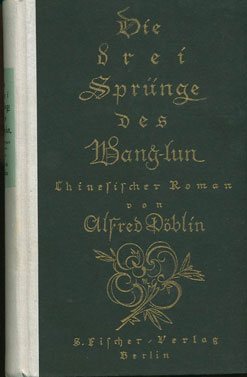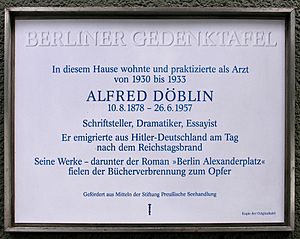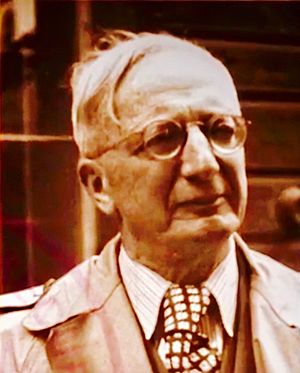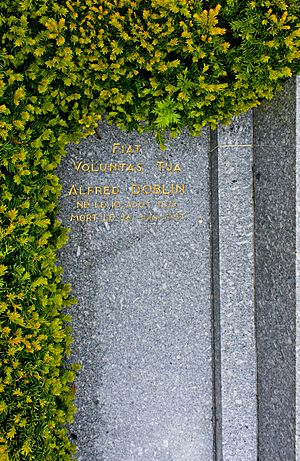Alfred Döblin facts for kids
Quick facts for kids
Alfred Döblin
|
|
|---|---|
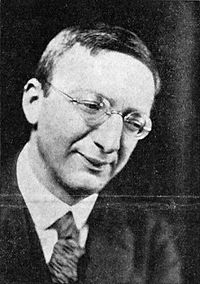
Döblin c. 1930
|
|
| Born | Bruno Alfred Döblin 10 August 1878 Stettin, Pomerania, German Empire (now Szczecin, Poland) |
| Died | 26 June 1957 (aged 78) Emmendingen, West Germany |
| Pen name | Linke Poot |
| Occupation | Writer, doctor |
| Nationality | German, French |
| Period | 20th century |
| Genre | Novel, essay |
| Notable works | Berlin Alexanderplatz, The Three Leaps of Wang Lun, Wallenstein, Berge Meere und Giganten, Manas, November 1918: A German Revolution, Tales of a Long Night |
| Spouse | Erna Reiss |
| Children |
|
| Relatives | Hugo Döblin (brother) |
| Signature | |
 |
|
Bruno Alfred Döblin (born August 10, 1878 – died June 26, 1957) was a German writer and doctor. He is most famous for his novel Berlin Alexanderplatz (1929). Döblin wrote many books over more than 50 years. He is considered one of the most important figures in German modernism, a style of art and writing that broke away from traditional ways.
His works include novels, plays, radio shows, and essays. His first published novel, The Three Leaps of Wang Lun, came out in 1915. His last novel, Tales of a Long Night, was published in 1956, a year before he passed away.
Döblin was born in Stettin, Germany (now Szczecin, Poland). His family was Jewish. When he was ten, his father left, and he moved to Berlin with his mother and siblings. He lived in Berlin for about 45 years. There, he met many important German artists and writers like Bertolt Brecht and Thomas Mann.
After his famous novel Berlin Alexanderplatz was published in 1929, Döblin became very well known. But when the Nazis came to power, he had to leave Germany. The Nazis considered his works "Asphalt literature", which was a term they used to criticize modern art and literature. He lived in France from 1933 to 1940. When World War II began, he had to flee again. Like many other German people who left their country, he spent the war years in Los Angeles, USA. There, he became a Catholic.
After the war, he moved back to West Germany. However, he did not feel comfortable with the culture there, so he returned to France. His last years were difficult due to poor health and money problems. His later books were not as popular.
Even though Berlin Alexanderplatz is a classic, Döblin is often seen as a writer who is not as well-known as others like Thomas Mann or Franz Kafka.
Contents
Life Story
Early Years
Bruno Alfred Döblin was born on August 10, 1878, in Stettin, a port city in what was then the Province of Pomerania. He was the fourth of five children. His father, Max Döblin, was a tailor, and his mother, Sophie Döblin, was a merchant's daughter. His older brother, Hugo Döblin, became an actor. His parents were Jewish, but they had adopted German customs. Alfred became aware of anti-Jewish feelings in society early in his life.
In July 1888, when Alfred was ten, his parents separated. His father left the family and moved to America. This event was very important in Döblin's childhood and shaped his later life. In October 1888, his mother and the five children moved to Berlin. They lived in a small apartment in a working-class area.
School was tough for Döblin. He was a good student at first, but his grades dropped later. He did not like the strict rules of the German school system, which was very traditional and military-like. This was different from his artistic ideas and free thinking. Even though he disliked school, Döblin loved to write and read. He admired writers like Heinrich von Kleist and Fyodor Dostoyevsky. He wrote his first novel, Jagende Rosse (Rushing Steeds), before finishing school.
University and Early Career (1900–1914)
After finishing school in 1900, Döblin went to Friedrich Wilhelm University (now Humboldt University of Berlin). He studied general medicine. In May 1904, he moved to Freiburg im Breisgau to focus on brain and mental health studies. He completed his medical degree in April 1905.
He worked as a doctor in different places, including a mental health clinic in Berlin. In October 1911, he opened his own private practice in Berlin. He later moved his practice to a working-class area of the city.
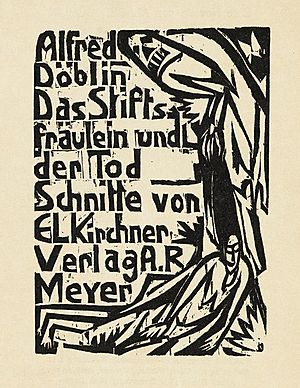
While working, he met Friede Kunke, a nurse. He later became engaged to Erna Reiss, a medical student from a wealthy family, and they married in 1912. Döblin had a son, Bodo, with Friede Kunke in 1911. Bodo was raised by his grandmother. Döblin stayed in touch with Bodo throughout his life. His first son with Erna Reiss, Peter, was born in 1912.
During his studies, Döblin wrote his second novel, Der Schwarze Vorhang (The Black Curtain). This book showed his unique writing style that he would later use in Berlin Alexanderplatz. He met Georg Lewin, also known as Herwarth Walden, who started the Expressionist magazine Der Sturm in 1910. Döblin became a regular writer for Der Sturm. Through Walden, he met other artists and thinkers who were part of the Expressionist movement in Berlin.

In October 1911, he met the painter Ernst Ludwig Kirchner. Kirchner painted several pictures of Döblin and drew pictures for some of his books. Döblin's early novel Der Schwarze Vorhang was published in Der Sturm. In 1912, his collection of short stories, Die Ermordung einer Butterblume und andere Erzählungen, was published. In 1913, he finished his third novel, The Three Leaps of Wang Lun. This historical novel about a rebellion in 18th-century China was a big success for Döblin. It brought him fame and the important Fontane Prize. He started writing Wadzeks Kampf mit der Dampfturbine (Wadzek's Struggle with the Steam Turbine) the next year.
World War I and Weimar Years (1915–1933)
To avoid being forced into the army, Döblin volunteered as a doctor in December 1914. He was sent to Saargemünd (Sarreguemines). At first, he was excited about the war, like many German thinkers. But soon, he became a pacifist, meaning he was against war. His son Wolfgang was born in 1915, followed by Klaus in 1917 and Stefan in 1926.
In August 1916, Döblin won the Fontane Prize for The Three Leaps of Wang Lun. After this, he started working on his historical novel Wallenstein, which was set during the Thirty Years' War. He finished Wallenstein by early 1919.
In 1919, Döblin moved into a new apartment and opened his medical practice in Berlin. This time after the war was difficult for him. Money was tight, and his sister Meta died in a conflict in Berlin. This showed how unstable Germany was after the November Revolution. During and after the war, Döblin became more interested in politics. He supported the political left, even though he never joined a party. He wrote political essays under the pen name "Linke Poot" (Left Paw).
In 1921, he met Charlotte ("Yolla") Niclas, a photographer. They became close friends for many years. That same year, he started working on his science fiction novel Berge Meere und Giganten (Mountains Seas and Giants), which was published in 1924. In 1924, he became president of the Association of German Writers.
In September 1924, he took a two-month trip through Poland. This trip was partly because of events in Berlin that made him think more about Jewish people. His travel stories were published in 1925 as Reise in Polen (Journey to Poland). From 1926 to 1927, Döblin worked on his epic poem Manas, about a figure from Indian stories. It was published in 1927. Manas and his philosophical book Das Ich über der Natur were not popular with the public.
Despite his growing importance in the intellectual world of the Weimar Republic (he was elected to the Prussian Academy of Arts in 1928 with help from Thomas Mann), Döblin did not have much literary or financial success until later.
This changed in October 1929 with the publication of his novel Berlin Alexanderplatz. This book brought him national and international fame. Döblin soon turned Berlin Alexanderplatz into a radio play and helped write the script for the film version, which came out in 1931. The early 1930s were the peak of Döblin's fame. He gave lectures and readings and tried to unite intellectuals against the rising power of the National Socialists. Just over a month after Hitler became leader, Döblin left Germany on March 2, 1933.
Exile and Later Life (1933–1957)
After a short stay in Zürich, Döblin and his family moved to Paris. He met other writers and artists there. He finished his novel Babylonische Wandrung in 1933. In 1935, he started working on his Amazon Trilogy, which tells the story of how South America was colonized and Christianized. This was published between 1937 and 1938. He also began his four-part novel project November 1918 about the revolution in Germany at the end of World War I. He became a French citizen in October 1936. In May 1939, he visited the United States for a writers' conference. He met President Franklin D. Roosevelt and his old friend Ernst Toller.
When World War II started, the family fled Paris. Döblin worked for the French government, writing texts against Nazi Germany. In 1940, at 62 years old, he had to leave again because Germany invaded France. He spent weeks in a refugee camp. During this time, he started attending church, which led to him becoming a Catholic the next year. On September 3, 1940, Alfred, Erna, and Stefan sailed to New York and then moved to Los Angeles. Döblin worked briefly for a film studio, writing screenplays. On November 30, 1941, Alfred, Erna, and Stefan became Roman Catholics.
Döblin finished November 1918 in 1943, but he could not find a publisher for it. He felt isolated and disappointed by his struggles in exile, especially compared to more successful writers. On his 65th birthday in 1943, a party was held for him in Santa Monica. Many famous writers and artists attended, including Thomas Mann and Bertolt Brecht. However, the mood changed when Döblin spoke about his conversion to Catholicism, which many found surprising.
In 1945, Döblin's 18-year-old son Stefan joined the French army. They also learned that his son Klaus was alive in Switzerland after working for the French resistance, but his son Wolfgang had died. In October 1945, Alfred and Erna returned to Europe. They settled in Baden-Baden, Germany. Döblin worked for the French military government, approving books for publication. He strongly opposed publishing texts by authors who had supported the Nazis.
Döblin was disappointed with the cultural situation in postwar Germany. He felt isolated and marginalized. In 1953, Alfred and Erna returned to Paris.
His last novel, Hamlet oder Die lange Nacht nimmt ein Ende (Tales of a Long Night), was published in 1956 and was well received. Döblin's final years were marked by poor health, including Parkinson's disease. He spent time in clinics and hospitals. He received more money from the German government for being a victim of Nazi persecution, and a literary prize, which helped with his medical costs.
Alfred Döblin died in a hospital in Emmendingen on June 26, 1957. He was buried two days later in the village cemetery at Housseras, France, next to his son Wolfgang. His wife Erna later joined them in the same cemetery.
Major Works
The Three Leaps of Wang Lun
Die drei Sprünge des Wang-lun (The Three Leaps of Wang Lun) was Döblin's third novel, but the first one published as a book in 1916. This long historical novel tells the story of a rebellion in 18th-century China. Critics liked it for its detailed descriptions of China. Wang Lun also influenced younger German writers like Bertolt Brecht. After Berlin Alexanderplatz, it is Döblin's most successful novel in terms of sales.
Wadzek's Struggle with the Steam Turbine
Döblin's funny novel from 1918 is seen as an early example of his experimental style, similar to Berlin Alexanderplatz. Wadzeks Kampf mit der Dampfturbine (Wadzek's Battle with the Steam Turbine) is about Wadzek, a factory owner who is losing a fight against a stronger competitor. He tries to fight back in increasingly strange ways, even defending his family's garden house. In the end, he has a breakdown and flees the country on a steamship powered by his competitor's machines. Döblin wrote this novel in 1914 and revised it while serving as a doctor in World War I. It was published in 1918.
Wallenstein
Döblin's epic novel Wallenstein (1920) is about the Thirty Years' War. It was generally well-received by critics. The novel focuses on the conflict between Ferdinand II, Holy Roman Emperor and his general, Albrecht von Wallenstein. Wallenstein represents a new, harsh way of fighting based on power and money, while Ferdinand struggles to control events. Döblin saw many similarities between the Thirty Years' War and World War I, which was happening when he wrote the book. This novel is considered one of the most important historical novels in German literature.
Mountains Seas and Giants
Döblin's 1924 science fiction novel tells the story of human history from the 20th to the 27th century. It shows a terrible global struggle between technology, nature, and different political ideas. Berge Meere und Giganten (Mountains Seas and Giants) predicted many topics we talk about today, such as big cities, losing touch with nature, environmental damage, machines taking over, and humans becoming less human. It also touched on mass migration, global connections, strict governments, terrorism, government spying, genetic engineering, and chemical warfare. The book was experimental in its style and structure, and some critics found it difficult when it first came out.
Manas
This epic poem in free verse came just before Döblin's most famous work, Berlin Alexanderplatz. Döblin himself saw a connection between the two, calling Manas "Manas with a Berlin accent." When it was published, writer Robert Musil praised it, saying it "should have the greatest influence!" However, it has not received much attention from scholars.
Manas tells the story of a war hero who suddenly realizes the meaning of Death. He goes to Shiva's Field of the Dead in the high mountains to connect with souls. After hearing many sad life stories, he faints. Three demons enter his body, planning to use it to go to the human world. Manas's guardian, Puto, tries to get rid of the demons but accidentally kills the body. Manas's soul returns to the Field. Puto takes the body back home and then fights the demons in the mountains.
Manas's wife, Savitri, does not believe he is dead. She travels to the mountains to find him. Shiva notices her on his Field and connects with her. Savitri is able to reunite with Manas's soul, and he is reborn into his body. Savitri then joins Shiva on Mount Kailash.
In the third part, the reborn Manas enjoys being alive but does not understand his place in the world. He finds Puto fighting the demons, captures them, and they carry him back to the world. A village priest says that Manas and the demons together form a new, powerful being, perhaps meaning a human who is no longer innocent but has a full personality. When Manas destroys a temple, Shiva comes to stop him. But Manas calls out to nature, and Shiva has to let him go. The demons turn into winged panthers, and Manas rides them to connect souls who want to return with humans who are tired of life.
This powerful and sometimes confusing story is told in a strong, direct, and dramatic way, with changing moods and voices.
Berlin Alexanderplatz
Berlin Alexanderplatz is generally seen as Döblin's greatest work. It is an important book about modern city life in the Weimar Republic. Published in 1929, its new way of using different pieces of text together (like a collage) and its wide view of a modern city have made it a key work of literary modernism.
Berlin Alexanderplatz tells the story of Franz Biberkopf, who has just been released from prison. He wants to live a good life, but he quickly gets caught in a struggle "with something that comes from outside, that is unpredictable and looks like a destiny." Biberkopf faces many problems and disasters. The novel brought Döblin international fame. It was translated into English in 1931. It has been made into a film twice: once in 1931 and again as a 14-part TV series in 1980 by Rainer Werner Fassbinder. In a 2002 survey of 100 famous writers, Berlin Alexanderplatz was named among the top 100 books of all time.
November 1918: A German Revolution
November 1918: A German Revolution is a series of four novels about the German Revolution of 1918–1919. The four volumes are: Vol. I: Citizens and Soldiers, Vol. II A People Betrayed, Vol. III, Return of the Frontline Troops, and Vol. IV, Karl and Rosa. This series is the most important work Döblin wrote during his time in exile (1933–1945). Writers like Bertolt Brecht highly praised it.
Tales of a Long Night
Hamlet oder Die lange Nacht nimmt ein Ende (Tales of a Long Night) (1956) was Döblin's last novel. It is set in England right after World War II. The story is about Edward Allison, an English soldier who was badly hurt in the war. Back with his family, Edward has to deal with his war trauma, old family problems, and a confused sense of who he is. The novel explores themes like finding oneself, guilt, responsibility, relationships between men and women, war, violence, and religion. Döblin wrote the novel between 1945 and 1946, but it was not published until ten years later. When it came out in 1956, it was well received. The title's reference to Hamlet likely came from Döblin reading Sigmund Freud's ideas about Shakespeare's Hamlet.
Legacy

Döblin is considered one of the most important German writers of the 20th century. However, most people only know his work Berlin Alexanderplatz, which is seen as the classic German novel about a modern big city. His writing style is known for using montage (putting different pieces of text together) and changing viewpoints. He also used what he called a "fantasy of fact" – mixing ideas from different fields like medicine, anthropology, and religion to describe experiences and explore new knowledge. His involvement with art movements like futurism, expressionism, and dadaism led one critic to call him "perhaps the most significant representative of literary modernism in Berlin."
In 1967, writer Günter Grass said that his own writing would not be possible without the modern elements in Döblin's work. Döblin also influenced writers like W.G. Sebald and Bertolt Brecht. Brecht wrote in 1943, "I learned more about the essence of the epic from Döblin than from anyone else."
Many of Döblin's complete works have been published in German since the 1980s. International Alfred Döblin conferences have been held every two years since the early 1980s. However, only a few of his other novels have been translated into English. Some of his autobiographical works have also been translated, including Destiny's Journey, which tells the difficult story of his flight and exile in the 1940s, and his Journey to Poland.
Döblin's papers and original writings are kept at the German Literature Archive in Marbach am Neckar.
See Also
 In Spanish: Alfred Döblin para niños
In Spanish: Alfred Döblin para niños
- Exilliteratur
- Expressionism
- Modernist literature



